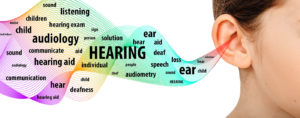Hearing Tests for Toddlers
I’ve always wondered how doctors could determine if babies and small children could hear well. I remember hearing tests in grade school where they had you wear headphones and raise your hand when you heard that oh so annoying “beep” but when they told me that my younger son would need to be regularly tested for hearing deficits I couldn’t help but wonder how they would know if he was hearing anything since he can’t actually tell us – at least not yet.
When my son was an infant his audiology team used sensors to measure his brainwaves when playing him sounds to determine if he was hearing them or not. He failed the test as a newborn and again at 3 months showing that he had minor losses in both ears but at 6 months old he was able to pass within normal ranges. You can read about my experience with those tests HERE. Afterward, we were advised to get my son’s hearing tested again when he turned one which is what lead me to the initial question.
For the test that measured my son’s brainwaves, my son needed to be asleep for it to measure correctly. At a year old, there was no way that I was going to be able to get my toddler to 1) sleep on demand and 2) stay asleep for the duration of the test. My son is VERY independent and everything is on HIS terms, not mine, so schedules have been tricky. (More on that another time) So I wondered…. Without being able to have him asleep to use the brainwave test and without him having speech to tell us anything… how on earth would his audiologist be able to tell if he was hearing anything?
As it turns out, pediatric audiologists are among some of the most patient people. On the day of my son’s test, she led us to a small darkened room and had me sit in a chair with Matthew (my one-year-old) on my lap facing a window that led to another room. On the walls to the left and right of the window were speakers and above those, little black boxes. After getting us set up, the audiologist closed the door and went into the adjoining room behind the glass. There she used a microphone to talk to us.
She explained to me that she would talk to Matthew or play a sound through one of the speakers and if he turned his head to look where the sound was coming from, the corresponding black box would light up to reveal an animatronic dancing animal. One side held a cow and the other an elephant. She explained that after she “conditioned” Matthew to respond in this way that she would be able to use his actions to tell if he was hearing the sound and then reward him with the dancing toy.
I have to admit, it was pretty amazing and it worked like a charm! Even better, Matthew passed the test again despite his small ear canals. He laughed at the dancing animals and actually seemed to enjoy the whole process. He didn’t get upset at all until the audiologist tried to put little earphones into his ears to test each ear separately. He hates having his ears touched. Once the earphones were set though, he was good to go. The whole process was much less traumatic and stressful than I had envisioned.
Why am I sharing this with all of you? Well firstly because I thought the test was neat but also because I’m sure that there are other mamas out there who have tots needing a hearing test and when you know what to expect it’s way less scary. Do you have questions? I’m happy to answer them in hopes of helping other moms. Ask your questions in the comments and if I don’t know the answer I’ll try to find it for you. Best wishes! You Got This.
Image Courtesy of CDC.gov

